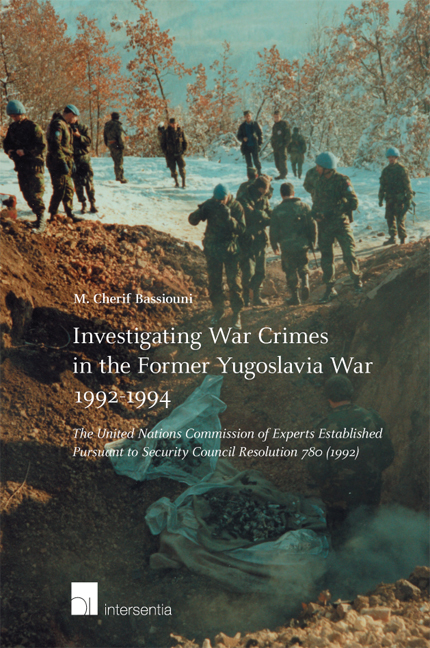 Investigating War Crimes in the Former Yugoslavia War 1992–1994
Investigating War Crimes in the Former Yugoslavia War 1992–1994 Book contents
- Frontmatter
- Contents
- Dedication
- About this Book
- About the Author
- Acknowledgement
- Table of Abbreviations
- Table of Authorities
- Chapter I Background on the Conflict in the Former Yugoslavia
- Chapter II Some Pictorial Descriptions
- Chapter III An Overview of the Realpolitik and the Workings of the Commission of Experts
- Chapter IV Precedents Leading to United Nations Security Council Resolution 780 (1992)
- Chapter V The Commission of Experts’ Establishment and Processes
- Chapter VI Final Report of the Commission of Experts Established Pursuant to Security Council Resolution 780 (1992) and Annex Summaries and Conclusions
- Chapter VII The Absence of a Transition between the Commission of Experts and the ICTY
- Chapter VIII Experiences that Affected Me the Most During My Tenure on the Commission of Experts
- Chapter IX Concluding Reflections
Chapter I - Background on the Conflict in the Former Yugoslavia
Published online by Cambridge University Press: 12 October 2018
- Frontmatter
- Contents
- Dedication
- About this Book
- About the Author
- Acknowledgement
- Table of Abbreviations
- Table of Authorities
- Chapter I Background on the Conflict in the Former Yugoslavia
- Chapter II Some Pictorial Descriptions
- Chapter III An Overview of the Realpolitik and the Workings of the Commission of Experts
- Chapter IV Precedents Leading to United Nations Security Council Resolution 780 (1992)
- Chapter V The Commission of Experts’ Establishment and Processes
- Chapter VI Final Report of the Commission of Experts Established Pursuant to Security Council Resolution 780 (1992) and Annex Summaries and Conclusions
- Chapter VII The Absence of a Transition between the Commission of Experts and the ICTY
- Chapter VIII Experiences that Affected Me the Most During My Tenure on the Commission of Experts
- Chapter IX Concluding Reflections
Summary
INTRODUCTION
The break-up of the Socialist Federal Republic of Yugoslavia (SFRY) and the resulting armed conflict occurred in stages, but it was really a single conflict that evolved in fits and bursts. The complex facts and circumstances underlying the conflict can be understood best by looking at the totality of factors that caused the conflict. World War II and post-World War II events were particularly relevant. Even more relevant were the political circumstances that caused the dissolution of the federal state and the competing claims of the different ethnic regions. The role of politics and the military in events preceding and following the dissolution of the SFRY were also relevant. The strategies and tactics employed in the conflict by the “warring factions” were largely the consequences of these factors and of other political, ethnic and strategic considerations. Notwithstanding the interrelated nature of the conflict and its genesis, it is useful to examine the conflict in its various stages and as between the different protagonists. By examining its different components, one can achieve a better understanding of its singularity and diversity.
In Slovenia, the conflict lasted from 27 June to 7 July 1991, in Croatia from 22 July 1991 to 3 January 1993, and in Bosnia and Herzegovina (BiH) from 4 April 1992 to the signing of the Dayton Peace Agreement on November 21, 1995. The conflict involved fighting between republics that declared their independence, and within these republics, among different ethnic and religious groups, with external support from one or the other of the states involved. Moreover, the conflict saw the widespread participation of civilians as combatants. These civilians sometimes acted as combatants in paramilitary forces and militias, at other times as agents of paramilitary forces, local civilian officials or national governments, and at still other times, civilian participation in the conflict appeared to have been spontaneous.
As the conflict evolved there were six warring factions and 86 paramilitary groups, many of whom engaged in contraband and organized crime activities. The warring factions pursued essentially political goals, but they also engaged in parallel organized crime activities. The warring factions carried high the political flag, which their actions did not necessarily justify. The conflict was further complicated by the establishment of breakaway republics within the newly independent states of BiH and Croatia.
- Type
- Chapter
- Information
- Investigating War Crimes in the Former Yugoslavia War 1992–1994The United Nations Commission of Experts Established Pursuant to Security Council Resolution 780 (1992), pp. 1 - 60Publisher: IntersentiaPrint publication year: 2017


